@periander345 a bath is ~5g malic acid + baking soda per L water (warm instead of hot is better for more co2) for covering body. tried it in an awkward to reach place on my back with a small round plastic container , sawed 2 slits in it and fed a thin tie through. It feels like an absolutely backward approach lol probably better to just lay back on top of a bowl filled to surface. tried glycerin gel and adding powders but doesnt sustain the reaction in small area
the co2 direct would probably only apply to tumors near skin level local to application site (they used tumor graft models)
Latest posts made by cs3000
-
RE: Studies showing cancer reversal / shrinkingposted in Bioenergetics Discussion
-
RE: Random, interesting studiesposted in Literature Review
@Mauritio interesting intuitively i noticed eating high carb only meal as last meal doesnt hit right , after pm rise in stress
and i was thinking, it probably exists to increase thermogenesis when the sun is set, with fats being better at that , matches your last part (wouldnt match the mice tho with active time at night, maybe for if they stop moving as much then)
serine has effect on resetting circadian rhythm
-
RE: Studies showing cancer reversal / shrinkingposted in Bioenergetics Discussion
10.1097/CMR.0000000000000577 https://pubmed.ncbi.nlm.nih.gov/30615010/
https://www.cancertreatmentsresearch.com/10-cases-of-complete-remission-from-stage-4-cancers-after-using-supplements-or-repurposed-drugs/
https://www.jaad.org/article/S0190-9622(04)03675-8/fulltextWe report a long-term complete remission of cutaneous melanoma metastases related to the use of a folk treatment with the plant Thymus vulgaris.
.Multiple cutaneous melanoma metastatic nodules were diagnosed after histologic and immunohistologic examinations (Fig 2, A and B). There were no lymph node or visceral metastases on clinical, analytical, or staging examinations (including body computed tomography, cerebral magnetic resonance imaging, and bone scintigraphy). The patient was staged at AJCC stage III, but she refused the proposed treatment, which consisted of hyperthermic perfusion of the left leg with melfalan and interferon.
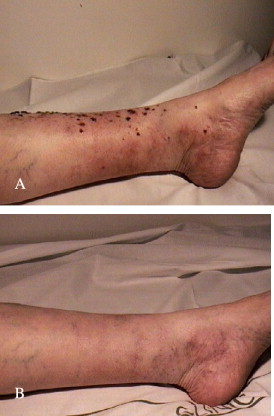
- A few weeks later, a progressive disappearance of all nodules was noted
Histologic examinations confirmed the complete regression of cutaneous metastases (Fig 2, C-F). The patient stated that she had been using dried thyme (ground leaves and stems) for herbal tea and for topical applications in compresses over the lesions. No evidence of disease in this patient is apparent after 5 years of follow-up.
No dose mentioned.
Dried Water extract shows potent effect at 500mg/kg in mice in other areas like lowering brain MDA. https://doi.org/10.1016/j.fct.2009.05.007
adding 1g - 10g of thyme stems to 1 kg diet showed inhibiting number of new tumors by 53% in the rat part, but no significant effect found on volume
But in the mice part of the study it showed great effect (breast tumors)
https://pmc.ncbi.nlm.nih.gov/articles/PMC6479806/#sec2-ijms-20-01749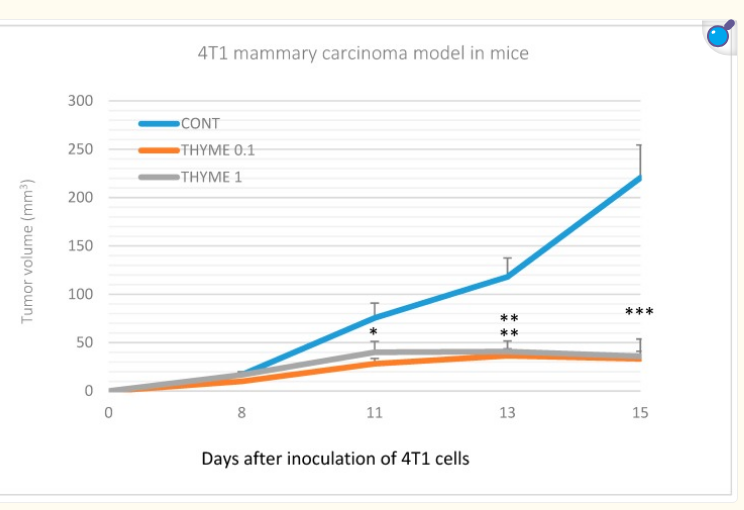
It stopped growing completely ~2 weeks (what would have happened if it was a couple weeks longer?)
-
Moreover, the T. vulgaris (THYME 1) dose significantly lowered total cholesterol levels by 11% (p < 0.05) versus THYME 0.1. A significant increase in serum glucose by 8.5% (p < 0.05) was observed in the THYME 0.1 group and by 19% (p < 0.001) in the THYME 1 group versus the control (data not shown). No differences in final body weight were observed between any groups. A significant increase in food intake was observed: +1.6 g (THYME 0.1) and +2.6 g (THYME 1) versus the control (14.7 g/rat/day).
-
By contrast, in mice, a reduced food intake was found in the THYME 1 group versus the control (1.51 versus 2.10 g/mouse/day). The doses of T. vulgaris were safe without undesirable side effects on rats after chronic administration (vitality/activity of animals, hair, mucosa, food and water intake, liver steatosis, hepato/splenomegaly, gastritis, or hematopoietic disorders)
Some methylation differences
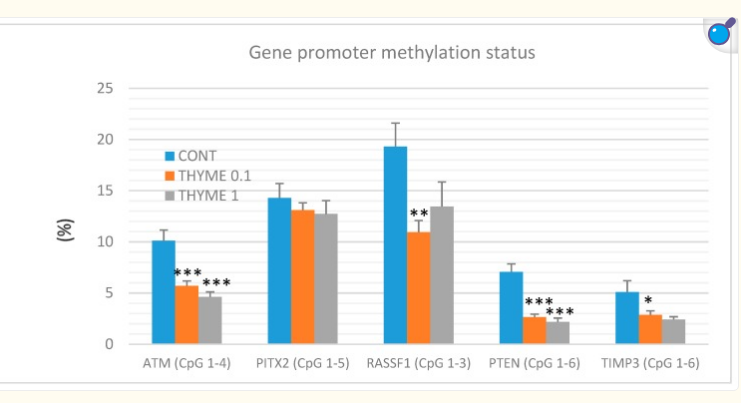
this result is outstanding as it overcomes the anticancer effects of well-validated synthetic drugs used in BC treatment: manumycin A [29] or paclitaxel [30] in the same 4T1 mouse model. In the chemoprevention study, the higher T. vulgaris dose significantly lowered tumor frequency, the most sensitive parameter of rat mammary carcinogenesis, by 53% compared to the control group. Contrary to the mouse model, the reduced dietary dose of T. vulgaris was ineffective in the NMU rat model. This result suggests that the sensitivity of different cancer cells in vivo (chemically-induced tumors or 4T1 allografts with different molecular characteristics) to phytochemicals of T. vulgaris is dose-dependent.
Complete remission of lymphoma with herb combination , 2 months
https://pmc.ncbi.nlm.nih.gov/articles/PMC9900160/#section2-15347354221147515-
The patient achieved a long-term complete remission and good quality of life over an 8-year follow-up under maintenance care of CHM. To the best of our knowledge, this is the first complete case report on DHL involving CHM.
-
Because of intolerance to the intensive chemo-immunotherapy, he stopped the chemotherapy at the third cycle about 7 weeks before he was recommended to our clinic in March 2014. It should be noted that this patient came to Chinese medicine treatment 7 weeks after the third cycle of chemo-immunotherapy which is longer than the usual 4 weeks from prior treatment
Another case of an 82-year patient with DHL was reported by Zaman et al.10 The patient initially received 3 cycles of R-CVP (Rituximab, Cyclophosphamide, Vincristine, and Prednisolone), but could not continue the intensive course of chemotherapy due to his compromised renal and blood parameters, and the patient died with the progression of the disease.
Cheema presented with another DHL case of unusual response after sequential aggressive chemotherapies.11 This was a man in his 50s with stage IIA DHL treated by R-Hyper-CVAD (rituximab plus cyclophosphamide, vincristine, doxorubicin, and dexamethasone alternating with methotrexate and cytarabine) but developed renal failure after the first cycle. The therapy was switched to R-ICE (rituximab plus ifosfamide, carboplatin, and etoposide) and induced complete remission. Unfortunately, the patient developed prolonged severe thrombocytopenia (grade 3) requiring a total of 4 units of platelet transfusion. By being treated with autologous hematopoietic cell transplantation (AHCT), he had a good tolerance and remained in complete remission for 1 year. These cases reveal that DHL has a poor prognosis and there is no accepted standard of treatment for DHL. The aggressive immunochemotherapy limits the outcome due to adverse effects or the intolerance of the patients.- the basic prescription was Sijunzi Decoction plus Prunella vulgaris with raw herbs used from March 2014 to March 2017 including Prunella vulgaris 20 g, Sophora flavescens 12 g, Scutellaria baicalensis 15 g, Salvia miltiorrhiza 12 g, Codonopsis pilosula 15 g, Atractylodes macrocephala 12 g, Poria cocos 15 g, and Glycyrrhiza uralensis 5 g. The herbs in the prescriptions were amended according to the patient’s responses. The CHM was administered daily in 2 separate decoctions: for the first decoction, 1000 ml of cold water was added to the herbal mixture, which was then boiled for approximately 50 minutes to reduce the volume to about 250 ml. This decoction was taken each morning. The remaining herbal mixture was used for making a second decoction which was taken each afternoon. This was prepared by using 750 ml of cold water and boiled for approximately 30 minutes to reduce the volume to about 200 ml.
After 2 months of the CHMs used, the patient felt his right groin mass disappeared.
His energy and digestion became normal. Blood tests showed that his hemoglobin and blood platelets became normal. LDH was reduced from 298 to 162 U/L, in the normal range. During the CHMs treatment period from 2014 to 2019, his adherence and tolerability to CHM were well maintained and no adverse events were observed. Follow-up CT imaging on the neck, chest, abdomen, and pelvis in May 2014 showed that the right iliac fossa mass had resolved with no residual mass.
no hematologic toxicity, hepatoxicity, or nephrotoxicity from CHMs were identified. Further follow-ups until 2020 found that he had been living and enjoying a good quality of life almost 8 years post-diagnosis.
It is important to note that the patient had continually received 5-year CHM maintenance care which may benefit his outcomes of long-term disease-free and good quality of life. The basic prescription of CHM used in this case is a well-known formula known as Sijunzi Decoction (SJZ). (they switched to granules later)
Melanoma & Inositol + IP6 , complete remission
In January 2015 the patient presented with a new subcutaneous lesion in his left medial thigh that was biopsied and confirmed to be BRAF V600E mutant melanoma. Left medial thigh melanoma was 3 cm in size. Restaging scans of the chest/abdomen/pelvis revealed a new mediastinal and right hilar lymphadenopathy with multiple pulmonary nodules (Fig. 2). Lactate dehydrogenase was within normal limits and he was staged as having a stage IVB disease.
The patient was offered systemic therapy with both immunotherapy and targeted therapy but he declined both and instead elected to pursue the combination vitamin IP6+inositol (800 mg/220 mg), five tablets in the morning and five in the evening daily. To our surprise, restaging scans 6 months later showed significant improvement. Subsequent CT scans showed continued response with a decrease in the size of the hilar and mediastinal lymph nodes and shrinkage of the left medial thigh in the transit lesion. The patient went into complete clinical and radiological remission after being on the vitamin combination for 2 years (Fig. 2). Three years after relapse, the patient remains in complete remission and continues to take IP6+inositol daily. We have not seen any subjective or objective evidence of side effects that can be attributed to high doses of daily IP6+inositol intake so farAnimal studies have shown that the combination of IP6+inositol provides additive anticancer Fig. 2 Computated tomography with the contrast of the chest before (left) and 2 years after (right) starting inositol hexaphosphate + inositol showing complete radiologic resolution of the upper right hilar lymph node. Inositol hexaphosphate (IP6) plus inositol Khurana et al. 323 Copyright r 2019 Wolters Kluwer Health, Inc. All rights reserved. properties than each given individually
- A few weeks later, a progressive disappearance of all nodules was noted
-
PQQ Pyrroloquinoline quinone (found in space dust)posted in Bioenergetics Discussion
https://pubmed.ncbi.nlm.nih.gov/8169668/
In the first experiment, weanling female BALB/c mice were adapted to a chemically-defined diet containing 0, 100, 200, 300, 1000, or 5000 ng PQQ/g of diet. The mice were bred and their reproductive performance and surviving offspring were assessed for 20-wk.
Reproductive outcome was markedly compromised for the groups most deprived of PQQ. Supplemented groups (> or = 1000 ng PQQ/g diet) had 8 pups/litter compared with 4-5 pups/litter in the PQQ-deprived groups (< or = 300 ng PQQ/g diet).
Of the pups surviving to weaning, 8 of 10 survived when PQQ was added to the diet (> or = 300 ng PQQ/g diet) compared with 4 of 10 in the PQQ/deficient group. The apparent requirement for PQQ for optimal growth of surviving neonates was estimated to be > 300 ng PQQ/g of diet.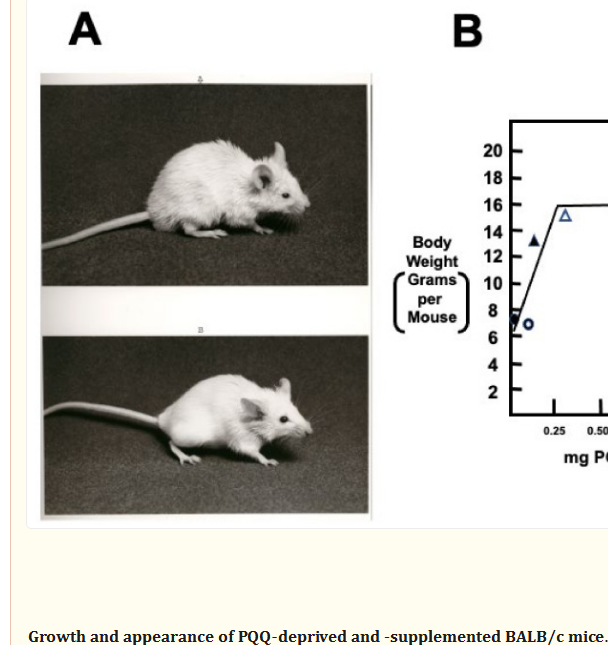
- Quinone cofactors may have had a role in early aerobic life on Earth. PQQ dependent methanol dehydrogenase has been found in many different types of bacteria including one archaea21. Recent results from the CIDA (Cometary and Interstellar Dust Analyzer) instrument on the Stardust spacecraft found numerous quinones, including ortho-quinones, in interstellar dust mainly from comet p/ Wild222.
pyridyl- and quinoline- quinones were the most likely compounds with the largest peak in the positive ion spectrum at m/z 331 which corresponds to PQQ23.
This has given rise to speculation that PQQ from interstellar dust played a key catalytic role in the early Earth. It is interesting to note that PQQ is known to only be made bacterially on Earth and that all the evidence strongly indicates that it is peptide derived. As far as we know, there are no bacteria or proteins in space to form the PQQ found in interstellar dust. This raises many interesting questions about the presence of PQQ and the origin of its biosynthesis.
Identification of lactate dehydrogenase as a mammalian pyrroloquinoline quinone (PQQ)-binding protein
https://pmc.ncbi.nlm.nih.gov/articles/PMC4882622/#sec8
(lowers lactate, increases nad+)protective effect works in very low nM concentration (1mg should be good) https://pmc.ncbi.nlm.nih.gov/articles/PMC9158787/
its an uncoupler

In the diet it reacts quick with things so isnt found much as free form, u largely get derivatives https://michaelrucker.com/functional-supplements/pqq-disodium-salt/Its seen as a vitamin like compound. some enzymes might rely on it. seen in mice
But as disodium salt form orally in drinking water, 20mg/kg mice didnt raise ATP. 20mg/kg injected i,p did https://actaneurocomms.biomedcentral.com/articles/10.1186/s40478-023-01642-6#Sec16
but i.p in rats caused kidney toxicity https://europepmc.org/article/med/2546903tho giving people 20mg improved cognition (protective benefit probably from these doses of the sodium form, acute atp boost takes higher https://www.jstage.jst.go.jp/article/jmi/71/1.2/71_23/_pdf/-char/en)
sleep improved well (scale 0 - 3 with 3 being highest dysfunction for individual scores) https://www.researchgate.net/publication/281323256_Effects_of_Oral_Supplementation_with_Pyrroloquinoline_Quinone_on_Stress_Fatigue_and_Sleep by 8 weeks
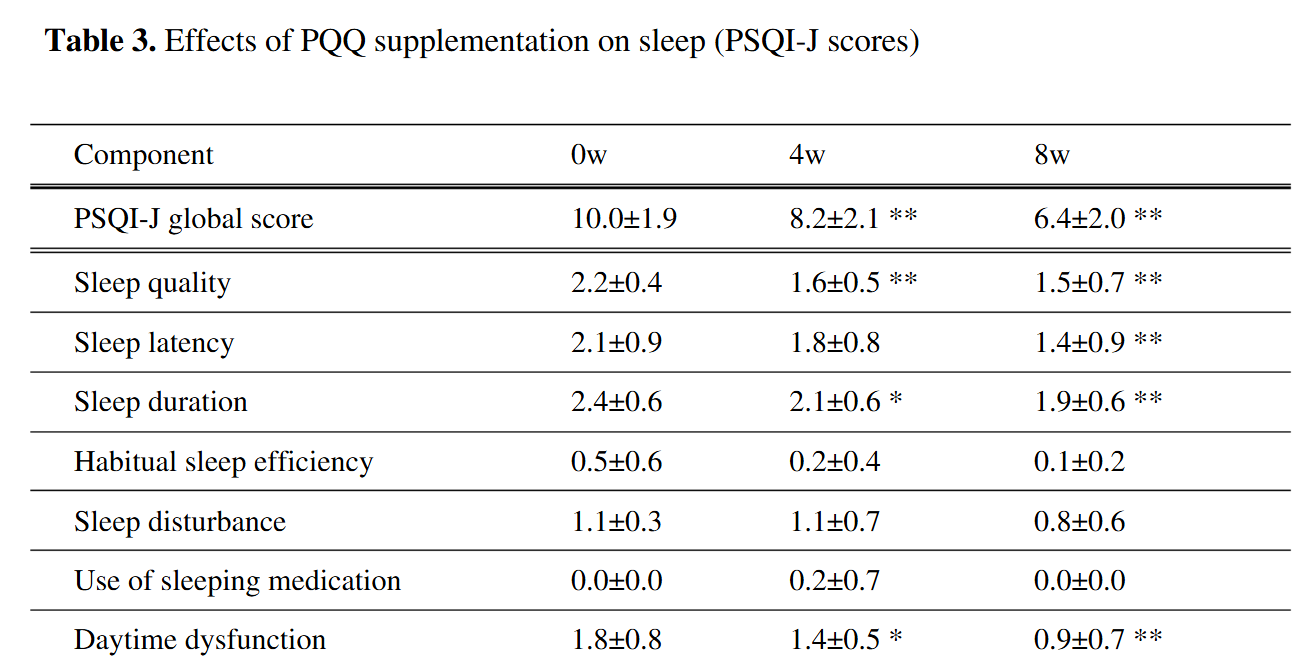
- Quinone cofactors may have had a role in early aerobic life on Earth. PQQ dependent methanol dehydrogenase has been found in many different types of bacteria including one archaea21. Recent results from the CIDA (Cometary and Interstellar Dust Analyzer) instrument on the Stardust spacecraft found numerous quinones, including ortho-quinones, in interstellar dust mainly from comet p/ Wild222.
-
RE: Studies showing cancer reversal / shrinkingposted in Bioenergetics Discussion
@Mauritio good idea i sent an email to idelabs
@eduardo-crispino thanks. they used 500mg normal vit c
curcumin inhibits glyoxalase 1 so should boost the effectiveness further (curcumin + vit c + creatine) but also might make normal cells more vulnerable, tho has some anti inflammatory effect too.
https://pubmed.ncbi.nlm.nih.gov/18946510/
good writeup
https://www.cancertreatmentsresearch.com/methilglyoxal/@alfredoolivas his book on archive.org the chemistry of natural immunity has more details
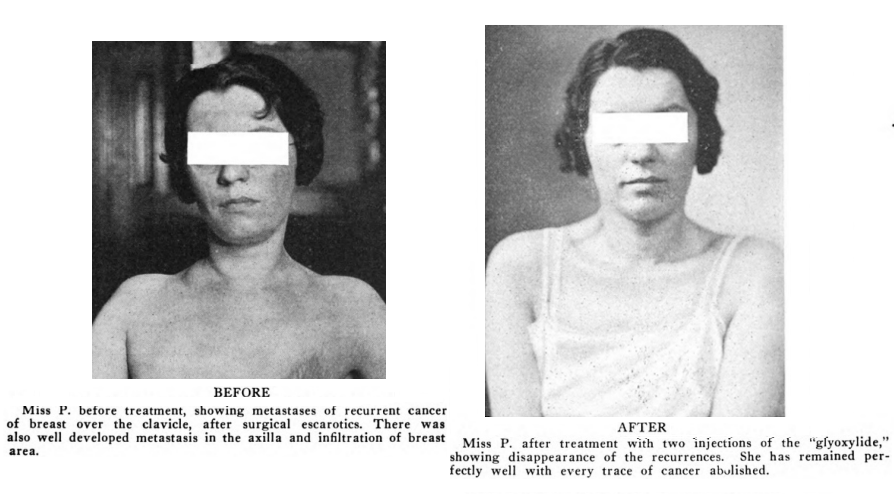
-
RE: Studies showing cancer reversal / shrinkingposted in Bioenergetics Discussion
Just noticed these replies @DavidPS @Mauritio William koch only used it for 1 or a few injections mostly (combined with protein aka methionine restriction while its doing its thing to boost response further) . So orally is extending things for lower potency over a longer time. doesnt sound like something beneficial to use generally at these amounts, but specific for outweighing effect on tumors (& other dysfunctions by the book) that looks profound. thanks something to weigh with diabetes, if the need to deal with tumors outweighs or if it can be offset at wounds locally e.g using co2 baths potentially. (radiation / chemo is probably not good for diabetic wounds either)
in the animal study below showing 80% complete remission (amazing result u dont see elsewhere, or without extreme toxicity) they tested high doses for 1 month on various animals. no significant detriment in behaviours, or toxicity to reproductive system, had healthy offspring, organs tested were fine
when they injected it they had initial pain, and eventually some swelling until 10 days after treatment ended (possibly repeat injections?).
So on the macro level at least looks safe enough in general condition considering results for 1 month, but with some proinflammatory effect. But this one, weirdly using much lower dose, but for longer at 6 weeks, showed impaired wound healing and some detrimental measures doi.org/10.1042/CS20050026 and over months showed kidney changes https://pubmed.ncbi.nlm.nih.gov/9740317/
whether creatine can protect from these changes too outside of the heart e.g in kidneys, not suremy take on that is the large doses arent showing much toxicity so seems its based on duration, seems to me its the proinflammatory effect building up creating damage over time
- Btw with right approach it might not need to be used for over a month. Not sure but it showed effect at 10 days in the animal study but that was before it was established. The human study didnt use creatine to boost the effect further. and theres curcumin which might make it more effective too. thats if using orally
@Mauritio 80% complete remission in animal study when vitamin C + creatine was added too
https://pubmed.ncbi.nlm.nih.gov/16112157/the creatine is there for extra safety for the heart and for some reason boosts the effect further
However, in all the normal types of cells tested, methylglyoxal was found to inhibit mitochondrial respiration in only cardiac cells. Creatine, which is abundantly present in these cells, could completely protect against the inhibitory effect of methylglyoxal
& dehydyroascorbic acid form of Vit C is another thing with 2+ carbonyl groups so there to boost effect at decent doses like 500mg+, im guessing it will go up with the ascorbic intake. like taking ubiquinol raises ubiquinone (actually raises ubiquinone more than taking ubiquinone)
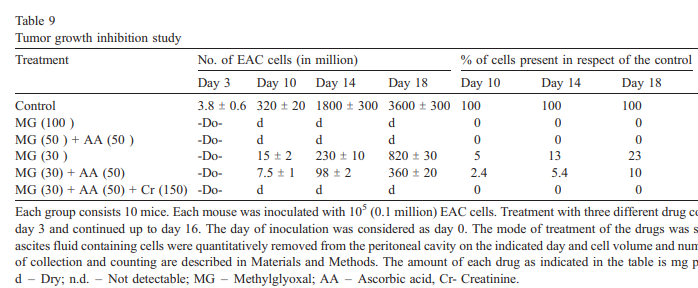
both methylglyoxal and methylglyoxal plus ascorbic acid treatment had significant inhibitory effect on cell proliferation. Moreover, treatment of methylglyoxal plus ascorbic acid plus creatine not only completely inhibited the cell proliferation but also made the peritoneal cavity completely dry.
human trial is here https://bioenergetic.forum/post/34639
-
RE: Panquinone experienceposted in Not Medical Advice
@Parrhesia the structure of this lol , 6 carbonyl groups all next to each other, looks special
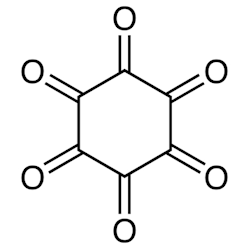
-
RE: Suggestions to help reverse severe sarcopenia in older type 2 diabeticposted in Not Medical Advice
@BroJonas
a post on a high carb low fat intervention study u can show him, https://x.com/cs3000_/status/1907744027748729155 (i wouldnt go 0% though. but fat can worsen insulin resistance, including fat released during overnight fast with the higher cortisol. fatty acids are higher in blood in people with diabetes too not just glucose, high fatty acids impair cells ability to use glucose). low carb hasnt helped because its not fixing anything fundamentallyfirst u could try:
3g-4g of basil (sweet basil) powder or dried leaves in tea , twice a day before meals with carbs (helps blood sugar in human and animal studies. some it fixes fully. effect if its gonna work would work progressively and would show well by about 1 month)& giving 100mg hesperidin a day (i wouldnt go much higher tho) as it helped reverse sarcopenia in aging https://cs3001.substack.com/p/orange-juice-for-muscle-loss-sarcopenia
and 3rd giving some extra thiamine daily might help as re-absorption is impaired in diabetes. cant use carbs well without it. animals avoid carbs when its low. i dont think high doses feel good though and supplements commonly 100mg. even 10mg-20mg is a boost. its 1 need sorted.
then with these a couple days at a time in a measured approach replacing fat with carb intake to see if it creates adaptation and normalises
-
RE: All things Histone Deacetylase (HDAC) and DNA Methyl Transferase (DNMT) inhibitory - reversing epigenetics from metabolic insultsposted in Not Medical Advice
Looked into the effect of sodium butyrate on causing senescence / stopping cells proliferate. it can do that to normal fibroblasts (even tho showed increased wound healing). but effect is selective
pretty good one showing this helps recovery after brain injury , https://pmc.ncbi.nlm.nih.gov/articles/PMC2726719/#S10
during continued poor blood flow to the brain it helped restore brain cells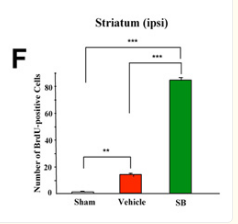
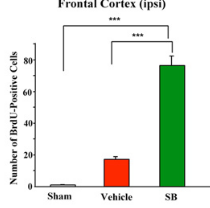
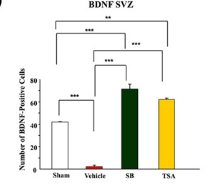
Day 14 after injury
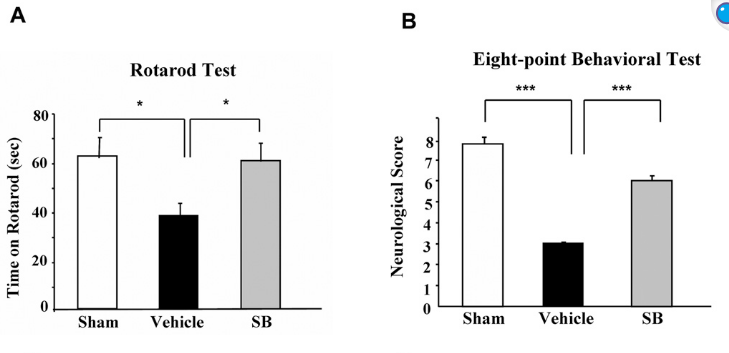
-
RE: Studies showing cancer reversal / shrinkingposted in Bioenergetics Discussion
@Mauritio all of it combined probably with methylgloxal being the main effect, maybe the low protein helps improve response rate,
In the modern trial ~40% of the people got complete remission of their tumors taken orally daily, without dietary changes mentioned just added vitamin C. Koch injected it just 1 time into muscle, then waited a couple weeks and repeated that twice more if needed
they tested some other stuff with efficacy on animals (human study mentioned low toxicity for the methylgloxal tho when done in vivo and as just methylglyoxal form)
other ones , they're "unsaturated diketones" or things that form them as "peroxides of substances that liberate free carboyl groups to form the unsatured diketone"
"Unsaturated diketones are organic compounds containing two ketone (carbonyl, C=O) functional groups and one or more double or triple bonds within their molecular structure. These unsaturated bonds make the molecule chemically reactive and allow for unique properties."
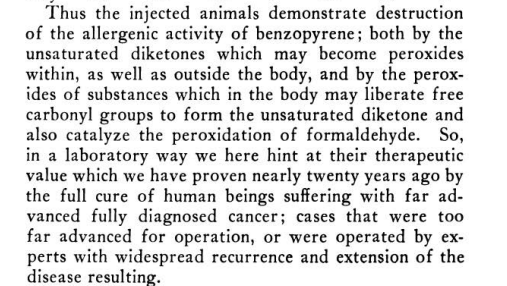
Something interesting, some of those substances create carbon dioxide when they degrade. or relates in some way
Quinones are unsaturated diketones
part of curcumin molecule is an unsaturated β-diketone https://casereports.bmj.com/content/2017/bcr-2016-218148 but generally they havent shown remission like the methylgloxal
some ketones like acetylacetone